And here we are. Three weeks away from the release of the (presumably) final chapter in the Star Wars movie saga, Star Wars: The Rise of Skywalker (or Star Wars: Episode IX). It’s been a long, interesting and exciting journey from the original Star Wars in 1977 (now known as Episode IV: A New Hope), that has two sequels, The Empire Strikes Back (Star Wars: Episode V) and Return of the Jedi (Episode VI), to The Phantom Menace (Episode I) sixteen years later and the two following that: Attack of the Clones (Episode II) and Revenge of the Sith (Episode III).
In the last four years, we returned to a long time ago in a galaxy far, far away for The Force Awakens (Episode VII) and The Last Jedi (Episode VIII). The first trilogy enchanted and thrilled audiences like no movie series had ever before and the second trilogy, well, they were successful certainly and there was much to admire about them. In fact, there’s even much to love about them. One, in particular, The Phantom Menace, has gotten a lot of hate directed at it and I will say upfront that it has always been my favorite of the prequels. I still find things to enjoy in it.
So, before The Rise of Skywalker hyperdrives its way into theaters next month, I’m sure there will be viewings of every previous episode beforehand and there will be those fans who will say “skip the prequels.” I won’t be one of those fans. I’ll be starting right at the beginning of the saga—with Episode I and you should too. There are a lot of great things there and here are some of them.
Star Wars: Episode I—The Phantom Menace
1. The Cast
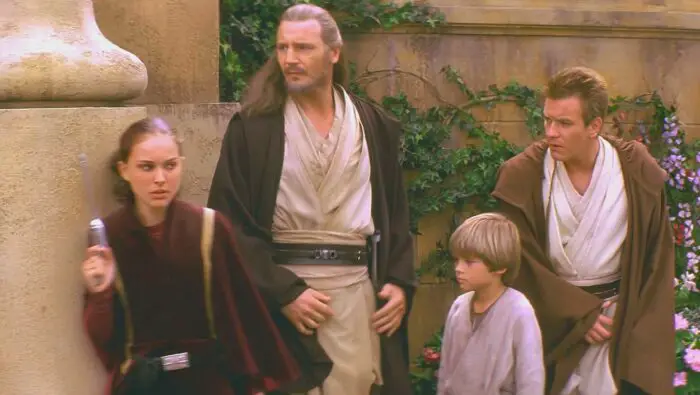
In the spring of 1997, casting was underway for Star Wars: Episode I—The Phantom Menace, the first installment in the second Star Wars trilogy. In fact, George Lucas and casting director Robin Gurland had been looking for actors to fulfill key roles as early as 1995. The candidates chosen would come in to meet with Lucas without being given a script. The key role of Jedi master Qui-Gon Jinn would be given to Liam Neeson based on his powerful performances in Schindler’s List and Michael Collins. Cast as young Obi-Wan was actor Ewan McGregor, soaring high from 1996’s Trainspotting.
Sixteen-year-old Natalie Portman from Leon, Heat and Mars Attacks! would play Padmé Amidala and, returning as Sheev Palpatine for the first time since Return of the Jedi, Ian McDiarmid. Not a bad bunch. Rounding out the main cast was Samuel L. Jackson as Mace Windu and Jake Lloyd as young Anakin Skywalker. Much has been said about Lloyd as Skywalker and I’m not going to pile on, but to me, it appeared Lucas was going for ‘cute’ instead of casting a child with a touch of darkness in him. Maybe Lucas felt the cuter the kid the more dramatic his ultimate turn to the dark side would be. Unfortunately, it didn’t work out that way. Regardless, this was a great group to watch onscreen and it sure looked like they were having fun.
2. The Podrace
Film historians (and Star Wars fanatics) know that young George Lucas nearly died one day in 1962 when his yellow Autobianchi Bianchina was in a fatal collision with an oncoming car. Lucas wasn’t at fault but his love for fast cars and racing nearly cost him his life. Racing was still on his mind as he recuperated and if he couldn’t race in real life, the characters in his movies were going to race for him. First, it was the hero of THX-1138 racing his way to freedom at the end of that movie, then it was the nightcrawling teens of American Graffiti and then it was Luke Skywalker, racing his landspeeder across the Tattooine desert whenever he managed to break free from that slave-driver Uncle Owen.
For The Phantom Menace, Lucas conceived of the ultimate race: a nearly ten-minute high octane race through canyons, valleys, and dirt between young Anakin Skywalker (who actually wasn’t that much younger than Lucas was in ’62) and dirty dug Sebulba. The pod race is a showstopper—a feast of sound and visuals that rivals anything in those Fast and Furious movies. Many fans complained that the race went on too long but it was still shorter than the battle of Yavin in Episode IV and the battle of Hoth in Episode V. Nobody ever complained about those. The complainers should be glad the pod race didn’t go as long as the battle of Endor in Episode VI. Now that was something to complain about.
3. The Lightsaber Battle
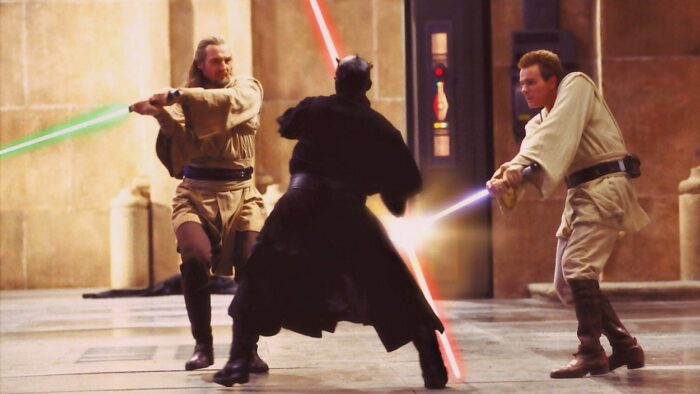
“I wanted to use the lightsaber a lot more in this film,” George Lucas said at the time of the film’s release. “It is a wonderful weapon because you can do almost anything with it. It is the ultimate weapon even though it is not very high-tech. For this movie, I wanted something that was lethal, but elegant and sophisticated.” In The Phantom Menace, lightsabers are used extensively to melt doors, slice through droids and battle evil Sith warriors.
For the movie’s conclusion, we witness an amazing battle between Qui-Gon, Obi-Wan, and Darth Maul whose double-sided weapon is one of the coolest things in the movie. The fight itself is a lengthy, furious spectacle where Jedi and Sith leap around on those high inner planet levels and chasms that populate Star Wars worlds. Despite how fans feel about the movie as a whole, it’s routinely felt that the lightsaber duel (accompanied to John Williams’s powerful goose-bump inducing “Duel of the Fates” music) is its most exciting and fan-pleasing scene.
4. The Music
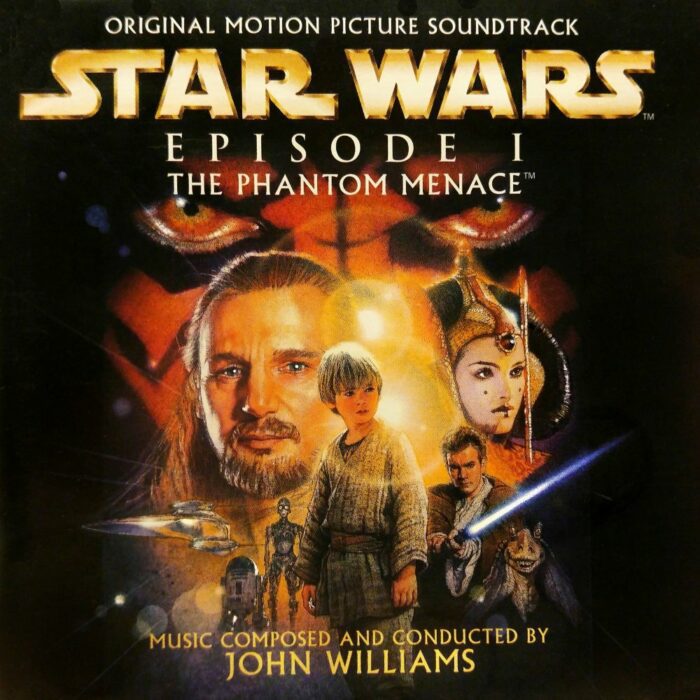
After a sixteen-year span between Return of the Jedi and The Phantom Menace, composer John Williams spent the better part of the late ’80s and much of the ’90s scoring more dramatic films which didn’t require the frenetic, non-stop style he was known for. Movies such as The Accidental Tourist, Presumed Innocent, JFK, Schindler’s List, Sabrina, Sleepers and Saving Private Ryan were quieter, emotional works by the composer. He worked on occasional big action scores such as Hook and Far and Away, but even those weren’t on the scale of Star Wars.
When Williams was shown a cut of The Phantom Menace in late 1998, he realized that almost every minute would require music—fast, energetic, complex, engaging, and thrilling music. It would be Williams’s most challenging work since his delirious writing for 1984’s Indiana Jones and the Temple of Doom. For Williams, ideas flowed and even though there were several new characters to compose themes for (Anakin, Jar Jar, Qui-Gon) there were familiar ones to expand on (The Emperor and the Force theme).
For Menace, Williams would write around 110 minutes of the score which The London Symphony Orchestra performed in the winter of ’99. Nothing said Star Wars is back more than when that first orchestral “BUMMMM” crashed onto the screen as the classic yellow Star Wars logo faded in the distance and the words “Episode I–The Phantom Menace” scrolled across. No matter what anyone felt towards the film when it was over, every fan agreed, Williams’s score was a standout. MTV even debuted the “Duel of the Fates” music video in May 1999 and was requested by viewers more times than Britney Spears’ “Baby One More Time.” Respect!
Star Wars: Episode II—Attack of the Clones
5. The Chase Through Coruscant
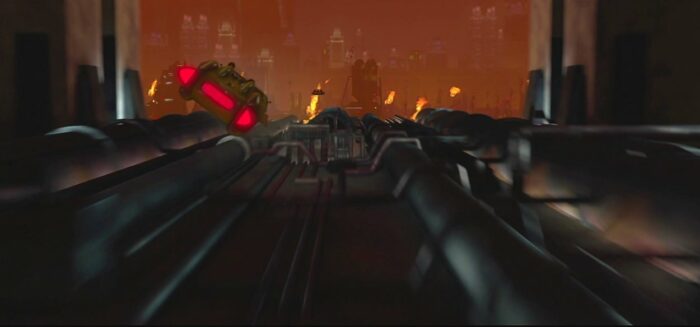
Star Wars meets Blade Runner in this exciting, lengthy chase from Episode II—Attack of the Clones. After a failed assassination attempt against Padmé by bounty hunter Zam Wesell (an interesting character who disappears from the franchise way too soon), Anakin and Obi-Wan hop in their flying speeder and engage in some hot pursuit to try and catch up with the shape-shifting bounty hunter. Too bad Wesell was a shape-shifting monster because, in human form, she/it was actually pretty cute. When Anakin drops in on Wesell, it forces a crash landing onto a busy side street where he pursues her/it into a bar filled with other nefarious types (stay away from those death sticks). It isn’t long before Obi-Wan catches up for a drink and to find out who exactly Wesell is working for. This is a pretty entertaining chase sequence which offered John Williams the chance to work a new sound into the action. Who knew an electric guitar in Star Wars would sound so cool?
6. Padmé’s Outfits
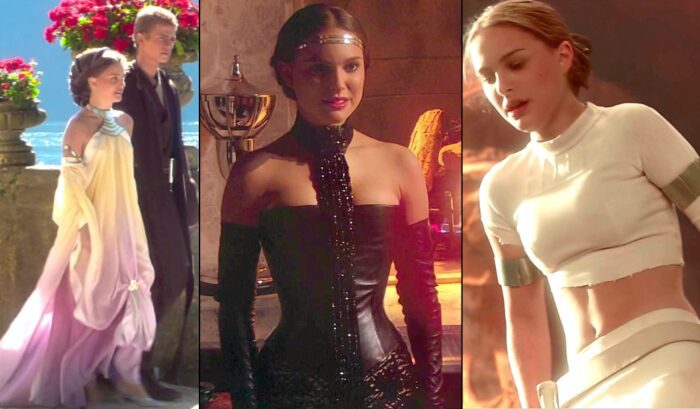
In Episode II, Padmé Amidala was featured in more outfits than Lady Gaga during awards season. Amidala, now a senator in the Royal House of Naboo along with Supreme Chancellor Palpatine, disappears from the political arena after the failed assassination attempt on her life by Zam Wesell. With Anakin Skywalker assigned to her as a bodyguard, Padmé had free time to wear a bunch of different outfits. First, there was the picnic dress which was perfect for flirting with Annie in and as her attraction to him developed, the sexier her wardrobe became. For her candlelit dinner where she confesses her feelings, she wore a leather corset and matching leather fingerless gloves (an outfit designed by Lucas himself).
When it was time to jump in the battle of Geonosis, she sported a white jumpsuit outfitted with a utility belt which displayed her very toned midriff (I’d love to see the galactic gym she goes too and the characters in there). And, for her secret wedding to Anakin, she donned a white gown of lace and beads with a lace veil. I’d imagine every designer in the galaxy wanted to have her wear their creations and from the look of those large trunks Anakin carried behind him once they arrived back on Naboo, she was happy to oblige. Costume designer Trisha Biggar (who had previously worked on Lucas’s Young Indiana Jones TV series) and concept artist Iain McCaig created many striking outfits for the prequel series characters but their Padmé creations were I’m sure, the envy of queens all across the galaxy.
7. The Battle of Geonosis
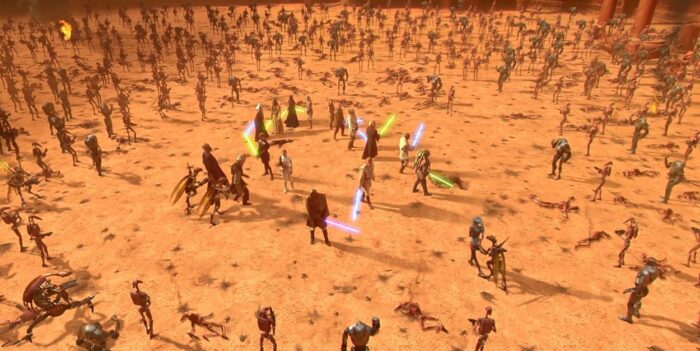
The bulk of Episode I‘s climactic battle occurred between the Gungan Grand Army and battle droids on Naboo so for the next installment, it made sense that the showdown would be larger and busier. Taking place on Geonosis, our heroes (Obi-Wan, Anakin, Padmé, Mace and the droids) fight droids, Nexu’s, Reek monsters, six-legged Acklay’s, Orray’s, dragon-like Massiff’s and bounty hunters all under the order of Sith lord Count Dooku in a gladiatorial arena. Being caught in the middle of this thing doesn’t look like fun and for one bounty hunter and his son, Boba, it was pretty horrible. It’s not a perfect sequence as it features C-3PO shooting at anything that moves like Rambo and the music was heavily recycled from The Phantom Menace throughout, but it’s still pretty fun and takes us right into a frenzied lightsaber duo between Dooku and Yoda. Who knew the little green guy could throw down like that?
Star Wars: Episode III—Revenge of the Sith
8. The Opening Battle/Rescue of Palpatine
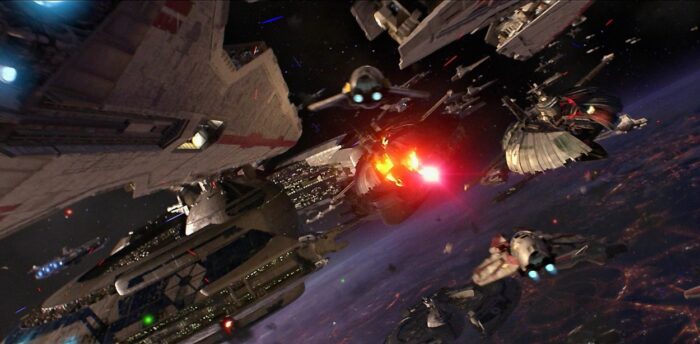
Episode II begins with exposition—a great deal of it. We were nearly 20 minutes into the movie before the first action sequence happened. For Episode III—Revenge of the Sith, we are immediately placed in the middle of a meaty, intense space battle between Anakin and Obi-Wan against a squadron of Imperial freighters high above Coruscant. Lucas tracks his heroes in their cruisers with a lovely single tracking shot which carries the viewer along with the pilots while John Williams incorporates a militaristic aspect to the classic Force theme.
It’s a breathtaking opening that restores some of that wonderful Star Wars feel. Continuing into the battle, we learn this is actually a rescue mission to find and retrieve Senator Palpatine from the cyborg General Grievous. But first, they have to deal with Count Dooku and more annoying astro-tech droids. After the Senator has been freed, Grievous surprises them by springing a deadly trap that could wipe them all out. After landing (barely) on Coruscant, the two Jedi’s warmly part ways. The next time they meet would not be so cordial.
9. Anakin v. Obi-Wan—The Battle of the Heroes
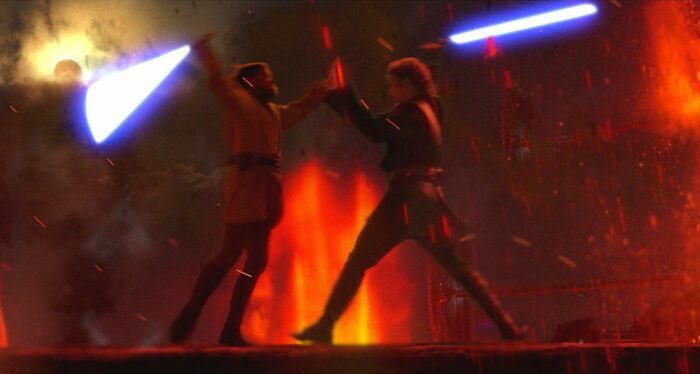
When Obi-Wan informed young Luke Skywalker in A New Hope that a young pupil of his named Darth Vader betrayed and murdered Luke’s father, he was half right. The seeds of Vader had indeed penetrated and consumed Anakin’s soul but Obi-Wan took care of the rest. I get that after Return of the Jedi fans assumed that if there ever would be another Star Wars movie, we’d see this climactic showdown—finally.
In 1995, when Lucas announced that he was preparing those movies, imaginations ran wild. Except when the next movie did roll out in 1999, they got The Phantom Menace with it’s Macauley Culkin-ish young Anakin and his goofy friend Jar-Jar. The bad news: the Vader/Obi-Wan showdown would have to wait until the final movie. The good news: once it did come, it would be tremendous. It was the first time in the three prequels where its characters dealt with pain and actual heartbreak. Sure, watching a lightsaber battle is always fun (The Phantom Menace), but when there are actual emotions behind each strike and blow (Empire Strikes Back) it hits hardest.
It also once more gave John Williams the opportunity to score another epic choral theme which sounds like angels screaming from above helplessly watching this duo fight for their lives. This battle for survival took place on Mustafar, a volcanic planet seething with the dark side which by no coincidence, resembled hell itself. As fans know, only one character would walk away from this fiery duel and the brutal fate of the other was so visually intense, Lucas had to trim a few frames out of the sequence to earn a PG–13 rating. Those who verbally doubted Lucas were suddenly left speechless. This battle was well worth the long, long wait.
10. The Birth of Vader
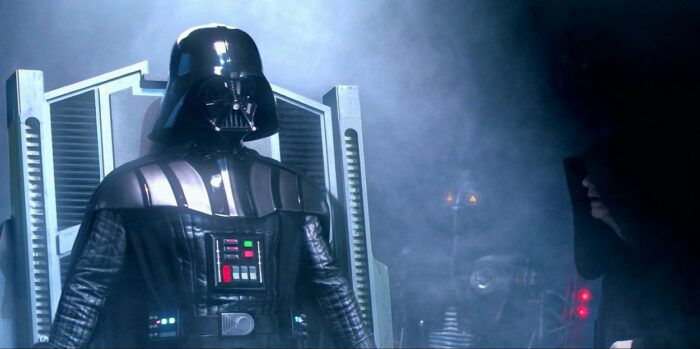
Star Wars finally gives fans what they’ve been waiting nearly 30 years for: to witness how Anakin was defeated by Obi-Wan and ultimately became Darth Vader, Lord of the Sith. It didn’t happen on top of an active volcano or inside a castle (which we finally would see years later in Rogue One: A Star Wars Story) as fans spent years and countless hours imagining but what we did see was pretty damn awesome.
With Anakin amputated and burnt nearly to death, what was left of him was found by Palpatine. A suit, a breathing apparatus, and a new voice would be made for the one who would no longer use the name Skywalker. More machine than man is exactly what Vader had now become. The ‘machine’s’ first words are heartbreaking (“Where is Padmé? Is she all right?”) as we know these would be the last words of concern for another being Vader will ever voice until his final moments with Luke in Return of the Jedi. Now, fully immersed in the dark side, Vader joined The Emperor on board a star destroyer where they gaze out at a vision of a battle moon which will ultimately be named, The Death Star (and would took 15 years to build where the second one would take less than three, but why nitpick?).
Vader’s “birth” is juxtaposed with Padmé’s death and Star Wars becomes The Godfather of sci-fi movies (where there, we watched the erosion of Michael Corleone’s soul as the people close to him paid the heavier price for their disloyalty). After the disappointments of the previous episodes, many wondered if Lucas had it in him to pull off the emotional power needed to conclude his story. There was no need to worry—he did, and it was absolutely shattering.



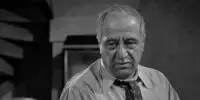
Great writing. i watched all Star Wars movies on the big screen, read a bunch of books and loved every moment of it, specially the music. That soundtrack made me collect soundtracks of hundreds of other movies; A joyous quest.